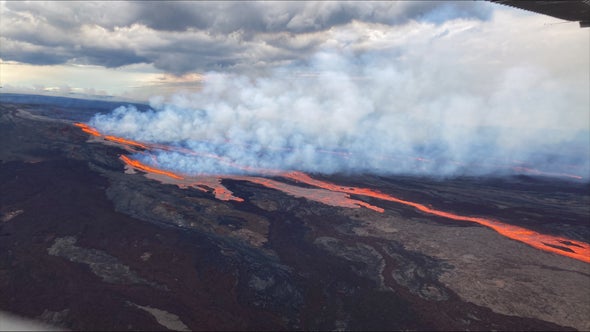Hawaii’s Mauna Loa volcano—the largest active volcano on Earth—erupted on Sunday night for the first time since 1984, flooding the bowl-like caldera at its summit with a pool of glowing lava.
The eruption was presaged by an increase in earthquake swarms and sections of the ground moving up and down at the summit caldera (called Moku‘aweoweo) starting in August, says Jessica Ball, a volcanologist at the U.S. Geological Survey. At approximately 11:30 P.M. Hawaiian Standard Time on November 27, lava started erupting within the caldera. By Monday morning, the eruption had migrated to the northeastern flank of the volcano, where fissures were feeding lava flows at high elevations.
The lava flows were not threatening any communities at the time this report was published. Flows are expected to remain within the Northeast Rift Zone, which is part of Hawaii Volcanoes National Park, according to the Hawaiian Volcano Observatory. But the situation could change, Ball says, and local authorities are monitoring the eruption closely. “With Mauna Loa, we don’t take chances,” she adds, “because it’s such a large and potentially destructive volcano.”
Mauna Loa is a shield volcano, a type that erupts fluid lava to form sloping, dome-shaped mountains. Its summit rises 13,678 feet above sea level. But from there, its base extends down another three miles to the seafloor—which is actually pressed down for an additional five miles by the massive mountain’s weight. From top to bottom, the Mauna Loa measures 10.5 miles high.
Like Hawaii’s other volcanos, it is fed by a plume of hot material that rises through Earth’s mantle under the Hawaiian Islands. But Mauna Loa is distinct from Mauna Kea and Kilauea, two of the other volcanoes that make up Hawaii’s Big Island. “They’re all fed from the same plume. But the storage areas, the magma reservoirs, are different,” says Ed Venzke, a volcanologist at the Smithsonian Institution’s Global Volcanism Program. “So the lavas that come out are chemically very distinct.”
Mauna Loa’s lava tends to be very liquid and fast flowing, Venzke says, and its eruptions are typically shorter lived than those at nearby Kilauea. The latter erupted from 1983 to 2018, when its caldera spectacularly collapsed.
Mauna Loa’s slopes are 90 percent blanketed with lava flows from eruptions that occurred within the past 4,000 years, clearly demonstrating the volcano’s active history. It last erupted 38 years ago, says David Clague, a volcanologist at the Monterey Bay Aquarium Research Institute, who was part of the response during that eruption. At that time, fissures on the northeastern side of the volcano sent flows rolling ominously toward the island’s biggest city, Hilo (whose current population is around 44,000)—but the lava never reached it.
Prior to the 1984 eruption, which lasted for several weeks, Mauna Loa burped out lava for about 20 hours over two days in 1975 in a summit eruption similar to the one seen on Sunday night. The opening of fissures on the volcano’s northeastern flank on Monday morning is reminiscent of the 1984 eruption, Clague says. Fortunately, the mountain’s lower slopes are gentle toward the northeast, and there are miles of moist rain forest that form a barrier to lava flows between the volcano and Hilo. “In 1984 the flows advanced, stalled and thickened, broke out a parallel flow, which stalled and thickened, rinse and repeat,” Clague says.
A graver concern would be fissures opening along the southwestern side of the volcano, as occurred in a 1950 eruption, he says. On this side, the slopes are steep, and lava can move quickly. “If fissures extend down the southwest rift zone, flows can rapidly advance into populated areas and even cut the main circumisland road within a matter of hours,” Clague says.
Monitoring equipment at Mauna Loa had set off alarm bells in recent months. On October 28 the Hawaii County Civil Defense Agency issued an alert warning of heightened unrest around the caldera. It was clear that magma was moving beneath the surface, Ball says, but whether or not such magma movements will lead to eruptions can be difficult to determine.
Currently, the greatest danger to human health is in the form of ashfall and volcanic gases such as sulfur dioxide, which are lung irritants. People downwind of the eruption should be alert to air quality notifications and stay indoors in the event of ash or a volcanic plume, Ball says.
Scientists are monitoring the eruption with ground-based gas sensors and instruments that can measure tremors and deformation of the ground. There are also satellite instruments that can track gases and heat and people with cameras stationed near the active regions. “The situation can change,” Ball says, “and sometimes quickly.”


